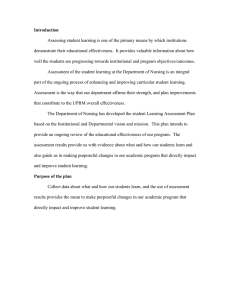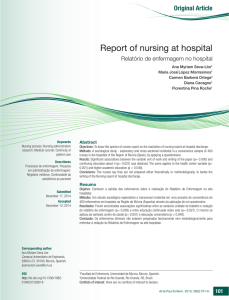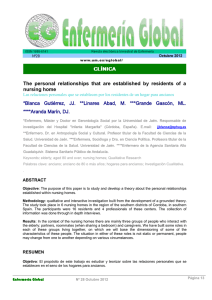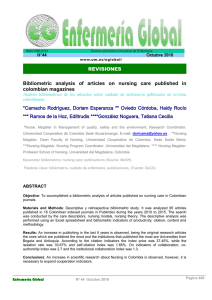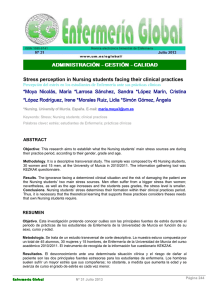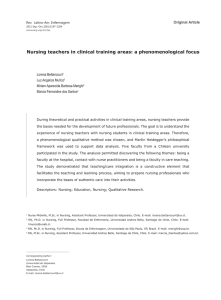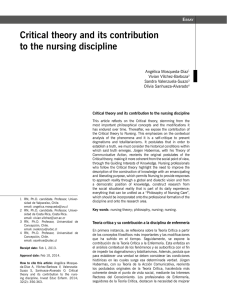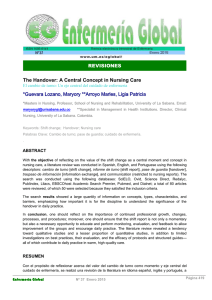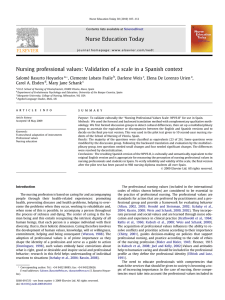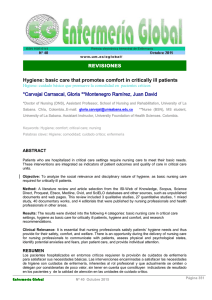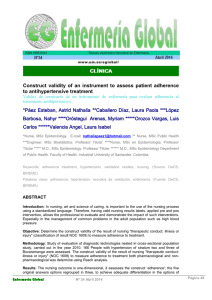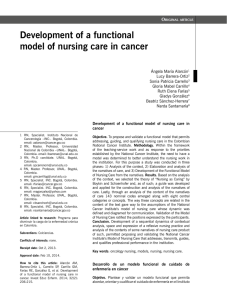Evidence of Art in Nursing
Anuncio
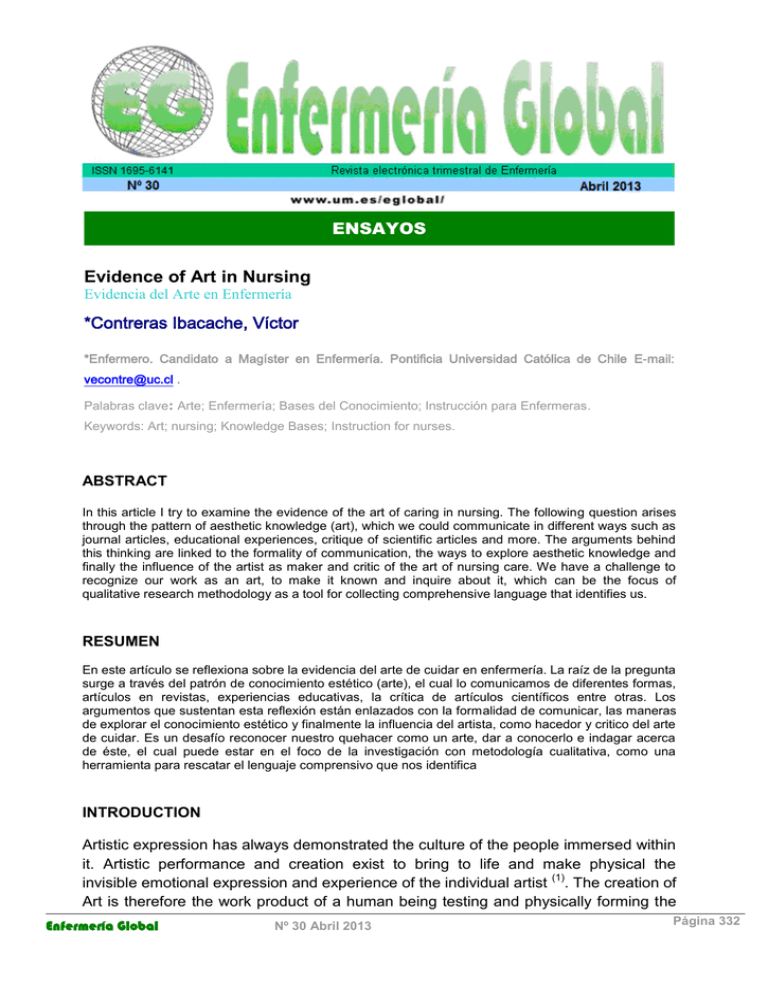
ENSAYOS Evidence of Art in Nursing Evidencia del Arte en Enfermería *Contreras Ibacache, Víctor *Enfermero. Candidato a Magíster en Enfermería. Pontificia Universidad Católica de Chile E-mail: [email protected] . Palabras clave: Arte; Enfermería; Bases del Conocimiento; Instrucción para Enfermeras. Keywords: Art; nursing; Knowledge Bases; Instruction for nurses. ABSTRACT In this article I try to examine the evidence of the art of caring in nursing. The following question arises through the pattern of aesthetic knowledge (art), which we could communicate in different ways such as journal articles, educational experiences, critique of scientific articles and more. The arguments behind this thinking are linked to the formality of communication, the ways to explore aesthetic knowledge and finally the influence of the artist as maker and critic of the art of nursing care. We have a challenge to recognize our work as an art, to make it known and inquire about it, which can be the focus of qualitative research methodology as a tool for collecting comprehensive language that identifies us. RESUMEN En este artículo se reflexiona sobre la evidencia del arte de cuidar en enfermería. La raíz de la pregunta surge a través del patrón de conocimiento estético (arte), el cual lo comunicamos de diferentes formas, artículos en revistas, experiencias educativas, la crítica de artículos científicos entre otras. Los argumentos que sustentan esta reflexión están enlazados con la formalidad de comunicar, las maneras de explorar el conocimiento estético y finalmente la influencia del artista, como hacedor y critico del arte de cuidar. Es un desafío reconocer nuestro quehacer como un arte, dar a conocerlo e indagar acerca de éste, el cual puede estar en el foco de la investigación con metodología cualitativa, como una herramienta para rescatar el lenguaje comprensivo que nos identifica INTRODUCTION Artistic expression has always demonstrated the culture of the people immersed within it. Artistic performance and creation exist to bring to life and make physical the invisible emotional expression and experience of the individual artist (1). The creation of Art is therefore the work product of a human being testing and physically forming the Enfermería Global Nº 30 Abril 2013 Página 332 shape of his or her own ideas and emotions in obedience to certain standards of beauty and aesthetics. Standards of beauty and aesthetics, whether individual or collective (cultural systems, cultural symbols), serve to deliver an understandable view of the world, which may be entirely textural or visceral in appeal or strongly communicative (1,2). Chinn & Kramer (3) put forward nursing as a form of aesthetic knowledge (art), in deep recognition of the situation of nursing, wherein the nurse must make use of his or her internal creative resources to transform the experience of patients and co-workers. Transformation, performance and creativity become visible through the action, behaviors, attitudes and interactions that occur in a given narrative. The narrative in question is that of a nurse in relation to others. The artistic act of caring, verbal and nonverbal, forms a unique relationship between the nurse and the interlocutor, which may be an individual or an entire community. Caring, and actions that impart care, are a transformative type of expression that symbolize the reality of an human experience (3), expressions that are perhaps unique in their quality to communicate something that is not necessarily seen today in aesthetic acts of communication, much less interactive ones (4). In accordance with the ideas of Porter (4), it is problematic to suppose that the traditional media of painting, sculpture, film, dance are the only “works of art” that are avenues of communicating the artistic expression or act. From the perspective of Porter (4), the question that arises is: How do we demonstrate and manifest the art of nursing? In the following essay, I will examine different arguments to answer this question. In exploration of the topic I will touch on a formal theory of communication, the ways in which aesthetic knowledge may be approached and finally enquire into the influence of the artist as creator and critic of the art of caring. FORMAL COMMUNICATION OF ART When first considering the artistic in terms of nursing, it bears emphasizing that professional nursing care is distinguishable from natural and innate care of human beings. What distinguishes nursing from simple caregiving is that the former is an intentionally established altruistic process, which attempts to instill a desire to help others in their life processes; in sickness, in health, in death and in recovery – establishing and guiding care in a theoretical system of knowledge (5). Apart from this theoretical system of knowledge, it is possible to establish different forms of introduction of care as it is enacted in every day life, which can be described as scientific evidence in nursing (5). Scientific evidence in nursing is an official and ritualized type of communication taking the form of scientific literature, which include an editorial committee and are disseminated in print or electronic form. Enfermería Global Nº 30 Abril 2013 Página 333 Within formal communications, one can find a diverse array of texts related to studies conducted under qualitative and/or quantitative methodology, as well as personal reflections, editorials, academic commentaries and other literary objects. From the perspective of art curator E. Ramírez (5), the literature may be a process of communication, a network, a creative collective process, a space of experimentation (typo)graphical, a comprehensive and practical format for the accumulation and dissemination of projects, a process of (re)production and an ideological vehicle as well as part of critical institution. As a creative typographical process and narrative, the scientific literature would be pieces of nursing art; as also would be other publications of nursing associations (such as websites about theory, philosophy and nursing models) which contribute to global awareness about nursing (5,7). Narrative forms (research, criticism, editorials) reported by scientific journals, are in and of themselves an artistic narrative act of nursing disclosed by written communication of the experience of relationships with others in the context of professional caregiving. Written expressions presented before an educated audience may be accepted, criticized or (re) used by the nursing community to exhibit characteristics of the care profession and the science of care. OTHER APPROACHES TO THE ART OF CARING In the search for scientific journals and articles referencing the art of nursing, the amount of proposals, which seek to communicate and reinforce our primary task, have surprised me. C. Delaney (8) published a pedagogic experience, which took place between himself and his nursing students at the art museum of his city. The goal of the assignment was to explore aesthetic knowledge in nursing. His idea was to reveal the attitudes and thoughts of the students as aesthetic patrons through the experience of a visit to the art museum. Delaney (8) discovered that the art curator has a similar job to that of a nurse. The curator must recognize how the artist created his or work, identify its context, help others to contextualize that expression embodied in the work and finally facilitate observation of the work itself. In the context of nursing this might be translated as perception of care and of the caregiver, seen from the perspective of the aesthetic patron who is intimately joined to the actions of the (patient) who receives care. Similarly, it should be recognized that the work of nursing care is unique, real and individual; it is a kind of innovative contribution to the current reality of people (patients, communities). Enfermería Global Nº 30 Abril 2013 Página 334 The laudable work of Delaney with his students (8) makes it possible to integrate the patron of aesthetic knowledge from the beginning of nursing training programs; emphasizing it as a way of communicating our mission, since many of us are mentors, guides, professors and supervisors/mangers. One experience that also supports this reflection is the proposal of Northington Wilkerson, Fisher and Schenk (9), who described the implementation of a reflection on the aesthetic pattern of nursing in the context of an pediatric nursing training environment, through the contributions of “non-scientific” literature (novels, stories, and other works) and audiovisual material (commercial films). According to Northington et al. (9), I may be able to say that the use of literary tools that are “non-scientific” and audiovisual - considered as pieces of art – whose content has communication with the experience of living with illness, abuse, incapacity and/or death of the individual and the perspective of the family, may benefit, through the medium of an aesthetic pattern, the life experiences of the clinic for nursing care students in a pediatric environment. I reiterate, that in the process of increasing sensitivity, awareness and understanding, the integration of an aesthetic pattern in everyday experience, may be a path to communicate our art. Therefore, for those who take care of others, these kind of experiences contribute to the understanding of human behavior and its responses, which is often difficult to grasp due to the varied expressions of people in relation to their health and to illness (9, 10). Tasks, such as those proposed by Northington, et al (9) and Delaney (8) allow the integration and consideration of the art of caregiving, which empowers students to think about their possible reaction scenarios before having to carry out interventions in a real environment. In continuation, one may say that the simulated clinical environments may even be able to integrate the elements of the art of caregiving, transforming the simulation into a kind of proof of a pattern of aesthetic knowledge – through the staging of situations which we experience on a daily basis, re-envisioning what it is that we do. G. Lindsay (11) published a brief piece of literature regarding how to read nursing practice professional literature articles published in peer-reviewed media. According to the author, one way of reconstructing and recognizing the meaning of an article is to read it critically, recovering the evidence which gives support to the interpretations, judgments, criticisms or items of debate suggested by the author. In short, Lindsay (11) reaffirms the idea of the “art critic in nursing” since the reading of an article is an exercise little different from the aesthetic evaluation of a work of art produced by an artist, which initially is a personal and subjective judgment, a very Enfermería Global Nº 30 Abril 2013 Página 335 human thing, but later becomes a judgment based on the artistic expression itself according to its context or progress, informed by empirical, contrastable data. Therefore, one may suggest that judgment, evidence, form and presentation are components of criticism that make an art curator the same as a nurse with respect to their practices, using different guides to raise an argument to accept or reject a certain work of art. THE EXPRESSION COMMUNICATION OF THE INDIVIDUAL (NURSE) AND ARTISTIC According to the perspective of Jean Watson, the relationship implied by human care is a transpersonal relationship (14), a union between the nurse and the person (individual or community), that is an artistic act and an expression of caregiving, which is unique and personal (3,5). Personally, the transpersonal relationship formed by the act of caring is based on life experience, individual beliefs, and self-exploration. Internal resources allow nurses to see and integrate themselves into the entirety of the act of care (10). At the same time, art is a selective recreation of reality that offers another method of development in understanding the deeper aspects of how human beings function in the work of nursing (15). For this reason it is possible for me to state, believe and conform every day, in my duty that each act is unique and personal, and in and of itself is a piece of art from our profession, which is communicated to others in the selfsame act of caregiving, exemplified by the acts of greeting a person when entering a hospital room. The act of greeting a patient with the intention of carrying out caregiving is a piece of art in which two people encounter each other. Notwithstanding the foregoing, at the current time it is a challenge to speak of art in nursing. I concur with Dr. M. S. Rivera who also terms it as thus, “… attention to how we are communicating our aesthetic knowledge. In a certain and yet very primal way, I believe that many times we do not know how to do it, we remain in the realm of the “scientific”…. Well enough… there is the great contribution of comprehensive research on life experience. There is the contribution of qualitative research, which provides a theoretical and philosophic framework that valorizes the human experience... ways of studying it and embracing its essence and communicating it in language…” (M.S. Rivera, personal communication, 19 June 2012). For this reason I reaffirm the idea that the experiences lived in the act of caregiving are artistic acts in and of themselves, in which we are urged to communicate consciously or unconsciously that which we have experience, in recognition of the fact that “… the art of nursing is difficult to explain and to conceptualize…” (K.O.personal Enfermería Global Nº 30 Abril 2013 Página 336 communication, 20 June 2012). We are always certain of having opportunities to make our art known to others. And at the same time, we communicate it in the moment that we make transpersonal relationships, which are capable of “understanding and adapting themselves to a variety of situations… using communication abilities in an appropriate manner in each case, in which the focus is the patient in an integral way” (K.O., personal communication, 20 June 2012). Finally, I may add that every day in each moment of our professional task (when giving care, educating patients, researching and communicating scientifically what we do), we are exemplifying our art, which has an enormous potential to understand the human experience in its totality. FINAL CONSIDERATIONS The way of communicating aesthetic evidence in nursing is not necessarily though “works of art” such as painting, sculpture and other traditional media. In each moment of caregiving, nurses are able to make visible our art and at the same time we can express it in actions that are estimable in themselves as works of art (from scientific communications to simple glances at the person under care). Professional training, and innovative interventions such simulations, are new challenges to aid in the comprehension and the communication of aesthetic patterns in nursing. Thus, we are our own art curators, who attempt to understand the art of nursing, criticizing our own form of care and in a certain way elevating it to a unique act that is given in the context of a relationship with others. However, it is a challenge to recognize our profession as an art, to introduce it and to investigate this characteristic of our work. Caring as art may be a new focus of qualitative research methodology, as a tool to recover the comprehensive language that identifies us. We are the artists of our own profession, playing the role of the protagonist in the act of giving care. We are both mentors and apprentices in this capacity; capable of both developing and communicating the art of nursing in the current world. REFERENCES 1. Velandia Ll. Historia del arte [Internet]; 2010. [cited 2012 Jun 4]. Available from: http://www.monografias.com/trabajos13/histarte/histarte.shtml 2. Wikipedia a. Historia del arte. arte [Internet]; 2012. [cited 2012 Jun 6]. Available from: http://es.wikipedia.org/wiki/Historia_del_arte Enfermería Global Nº 30 Abril 2013 Página 337 3. Chinn P, Kramer M. Theory and Nursing integrated knowledge develpoment. 5ta. ed. Missouri: Mosby; 1999. Chapter 1, Nursing´s fundamental patterns of knowing: p. 1 -15. 4. Porter S. Fundamental patterns of knowing in nursing: the challenge of evidencebased practice. Ans Adv Nurs Sci. 2010 Jan-Mar, 33(1): 3-14. 5. Rivera S. El arte de cuidar en Enfermería. Horiz Enferm. 2004, 15: 11-22. 6. Ramírez E. La Publicación y su Campo Expandido: el caso documenta 12 magazine. Arte y Crítica. [Internet]; 2008. [cited 2012 Jun 4]. Available from: http://www.arteycritica.org/index.php?option=com_content&task=view&id=383&Itemid =27 7. Alligood MR. Modelos y teorías en enfermería. 7th ed. Ámsterdam: Elsevier; 2011. Chapter 37, Estado actual y ciencia de la teoría enfermera; p. 754-761. 8. Delaney C. A trip to the Art Museum as a pedagogical approach to the teachinglearning of nursing aesthetics with RN to BSN students. J Nurs Educ. 2006, 45 (3): 143-144. 9. Northington L, Wilkerson R, Fisher W, Schenk L. Enhancing nursing student´s clinical experiences using aesthetics. J Prof Nurs. 2005; 21 (1): 66-71. 10. Mitchell G, Cody W. Ambiguous opportunity: toiling for truth of nursing art and science. Nurs Sci Q. 2002; 15 (1): 71-79. 11. Lindsay G. Reading journals: Recovery and Reconstruction of meaning for nursing praxis. J Nurs Educ. 2006; 45 (3): 143. 12. Ospina M. Procesos del Arte en Colombia [Internet]. Bogota: Instituto Colombiano de Cultura, Subdirección de Comunicaciones Culturales, División de Publicaciones; 1978. Chapter 32, Encuesta: “La crítica en Colombia” 1957; [cited 2012 May 31]; Available from: http://www.banrepcultural.org/blaavirtual/todaslasartes/procesos/cap32.htm 13. Wikipedia b Art criticism. [Internet]; 2012. [cited 2012 Jun 9]. Available from: http://en.wikipedia.org/wiki/Art_criticism 14. Jesse D E. Modelos y teorías en enfermería. 7ma ed. Ámsterdam: Elsevier; 2011. Chapter 7, Filosofía y teoría del cuidado transpersonal de Watson; p. 91-112. 15. Watson J, Biley F, Biley A. Aesthetics, postmodern nursing, complementary therapies and more: an internet dialogue. Complement Ther Nurs Midwifery. 2002; 8: 81-83. ISSN 1695-6141 © COPYRIGHT Servicio de Publicaciones - Universidad de Murcia Enfermería Global Nº 30 Abril 2013 Página 338
